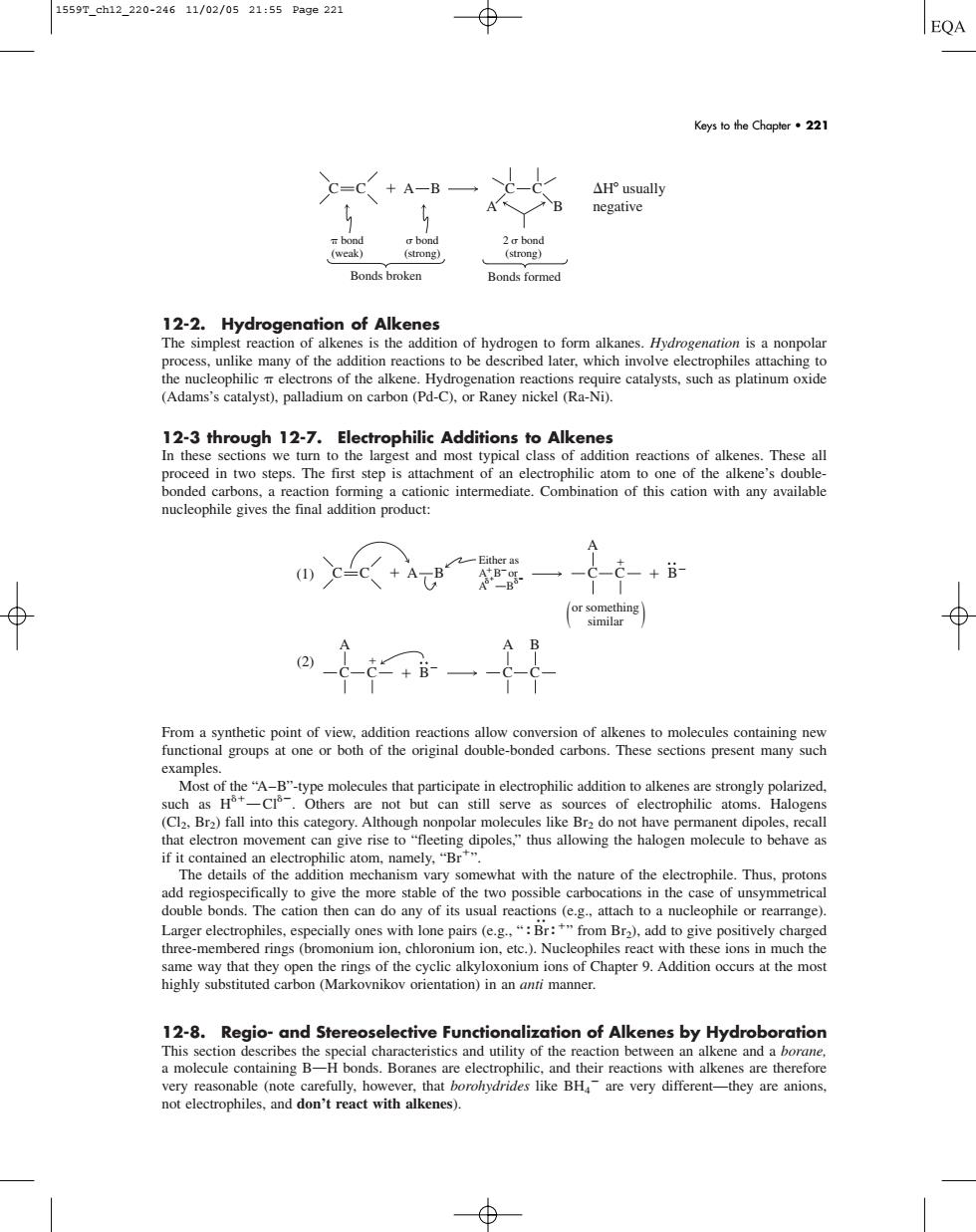正在加载图片...

15597ch12220-24611/02/0521:55Pag0221 EQA Keys to the Chapler·221 C=C+A-B一 △Hr°usualIy negative Bonds broken Bonds formed 12-2.Hydrogenation of Alkenes The simplest reaction of alkenes is the addition of hydrogento form alkanes.Hydro isa non process,unlik (Adams's catalyst),palladium on carbon (Pd-C).or Raney nickel (RaNi). 12-3 through 12-7.Electrophilic Additions to Alkenes othe larg hmtPpncalcdasofaditionreactions.ofalk bonded cabons.reacion forming a cationic intermediate.Combination of this cation with any avaib nucleophile gives the final addition product: From a synthetic point of view,addition reactions allow conversion of alkenes to molecules containing new functional groups at one or both of the original double-bonded carbons.These sections present many such Most of the"A-B"-typ e molecules that particinate in electrophilic addition to alkenes are str such as H Cl.Bra)fall into this category.A hough nonpolar mo if it contained an electr tion mechanism v dd double bonds.The cation then can do any of its usual reactions (e.gattach to a nucleophile or rearrange) Larger electrophiles.especially ones with lone pairs (e.g..":Br:"from Br).add to give positively charged three-mem red nngs (bro monium ior chloronium ion, 12-8.Regio-and Stereoselective Functionalization of Alkenes by Hydroboration12-2. Hydrogenation of Alkenes The simplest reaction of alkenes is the addition of hydrogen to form alkanes. Hydrogenation is a nonpolar process, unlike many of the addition reactions to be described later, which involve electrophiles attaching to the nucleophilic electrons of the alkene. Hydrogenation reactions require catalysts, such as platinum oxide (Adams’s catalyst), palladium on carbon (Pd-C), or Raney nickel (Ra-Ni). 12-3 through 12-7. Electrophilic Additions to Alkenes In these sections we turn to the largest and most typical class of addition reactions of alkenes. These all proceed in two steps. The first step is attachment of an electrophilic atom to one of the alkene’s doublebonded carbons, a reaction forming a cationic intermediate. Combination of this cation with any available nucleophile gives the final addition product: (1) (2) From a synthetic point of view, addition reactions allow conversion of alkenes to molecules containing new functional groups at one or both of the original double-bonded carbons. These sections present many such examples. Most of the “A–B”-type molecules that participate in electrophilic addition to alkenes are strongly polarized, such as HOCl. Others are not but can still serve as sources of electrophilic atoms. Halogens (Cl2, Br2) fall into this category. Although nonpolar molecules like Br2 do not have permanent dipoles, recall that electron movement can give rise to “fleeting dipoles,” thus allowing the halogen molecule to behave as if it contained an electrophilic atom, namely, “Br”. The details of the addition mechanism vary somewhat with the nature of the electrophile. Thus, protons add regiospecifically to give the more stable of the two possible carbocations in the case of unsymmetrical double bonds. The cation then can do any of its usual reactions (e.g., attach to a nucleophile or rearrange). Larger electrophiles, especially ones with lone pairs (e.g., “)Br >)” from Br2), add to give positively charged three-membered rings (bromonium ion, chloronium ion, etc.). Nucleophiles react with these ions in much the same way that they open the rings of the cyclic alkyloxonium ions of Chapter 9. Addition occurs at the most highly substituted carbon (Markovnikov orientation) in an anti manner. 12-8. Regio- and Stereoselective Functionalization of Alkenes by Hydroboration This section describes the special characteristics and utility of the reaction between an alkene and a borane, a molecule containing BOH bonds. Boranes are electrophilic, and their reactions with alkenes are therefore very reasonable (note carefully, however, that borohydrides like BH4 are very different—they are anions, not electrophiles, and don’t react with alkenes). C A C C C A B B CC C A C A B or something ( similar ( Either as A Bor A B B C C bond (weak) C A B C H usually negative A B Bonds broken Bonds formed bond (strong) 2 bond (strong) Keys to the Chapter • 221 1559T_ch12_220-246 11/02/05 21:55 Page 221������